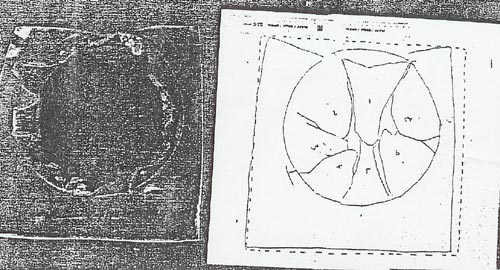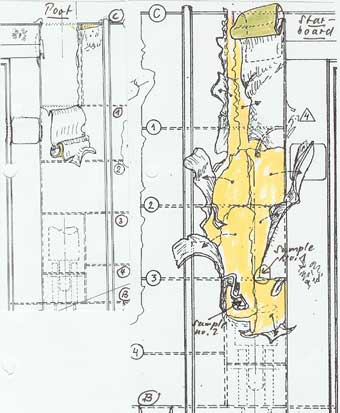Räjähdykseen viittaavia rakenteellisia muutoksia on siis todettu Estoniasta otetuista koekappaleista useamman kuin yhden instituutin toimesta:
https://www.estoniaferrydisaster.net/chapter05/05-0.html
"Sample 1 was entrusted to the Material Testing Laboratory (MPA) Brandenburg while sample 2 was handed over to the DN Institute, Clausthal-Zellerfeld (DN), for non destructive examinations.
Several weeks later the MPA Brandenburg presented its first results indicating that the tip of the sample had been affected by detonation. Sample 2 also showed destructions evidently caused by very high deformation velocity, which, however, could not clearly be defined as having been caused by detonation. Subsequently sample 1 was also examined by DN with the same positive results which were subsequently also confirmed by the South Research Institute, San Antonio, Texas/USA.
Brian Braidwood visited the MPA Brandenburg and exchanged views and discussed the examination results and methods used with the responsible persons in this Institute, i.e. Professor Ziegler, Dr. Nega and Dipl. Engineer Mettel. He also met and discussed the findings of the MPA Brandenburg with Martin Volk, the retired explosive expert of the City of Berlin.
Lt Commander Braidwood is working from his home office in Weymouth/UK but was closely informed and received the relevant documentation – translated into English – as soon as received.
His findings in the field of explosives in connection with the ESTONIA were frequently discussed with the also ex-military explosive expert Michael Fellows, who presented a paper at the AgnEf Seminar in Stockholm in May 2000 with the title “A Second Opinion on the Explosion Damage Report on the Car/Passenger Ferry Estonia by Brian Braidwood”. Michael Fellows concluded:
Sen sijaan Saksan liittotasavallan oma ja sitä kautta todennäköisesti enemmän poliittisesti ohjailtu asiaan perehtynyt instituutti BAM on kiistänyt räjähdykseen viitanneet jäljet, mistä alla oleva selvitys.
https://www.estoniaferrydisaster.net/chapter09/09-0.html
Raben dokumentissa kohdassa 17:50 Hannelore Mettel Materialprufungangstaldt Brandenburg:ista selostaa löydöksiään koepalasta, jotka hänen mukaansa viittaavat räjähdykseen. BAM oli eri mieltä, mutta Royal Military College of Science / Cranfield University:stä tohtori herra Michael Edwards oli taas sitten sitä mieltä (kohta 21:15 eteenpäin), jotta kyllä on mahdollista että koepalassa olevat rakenteet voivat syntyä vedenalaisessa räjähdyksessä, jos räjähteen ja metallilevyn, josta koepala oli Estoniasta otettu, on pienikin etäisyys.
Vieläpä joku DN-instituuttikin on sakemannien mukaan tullut siihen tulokseen, että yksiselitteisesti on räjähdys vaikuttanut koepalaan. Mitä käydään läpi heidän raportissaan. https://www.estoniaferrydisaster.net/chapter07/07-0.html
Mikä osoittaa että toveri inscout esittää muunneltua totuutta, mikä varmaankin johtuu siitä että hän ottaa virallisen tutkimustyöryhmän tulokset ja tarkennukset sellaisenaan ja uskoo niihin kuin vakaumuksellinen kristitty raamattuun. Ja esiintyy tieteellisyyden airueena ja ohittaa pilkalliseen sävyyn nämä siviilitieteellisten ja sotatieteellisen instituuttien tulokset.
Ja vastaväitteeksi ei nyt vaan kelpaa pilkalliseen sävyyn esitetyt kommentit että Jutta Rabe ja sakemannit on ihan paskoja. Jos vaikka olisivatkin, ei tarvitse edes hyväksyä Rabea ihmisenä tai oliona (tai sakemanniryhmän jäseniä), mutta nuo dokumentit + videokuvat Hanneloresta ja herra Edwardsista on huomioitava sellaisenaan. Vai onko nuo likaiset brititkin ihan paskoja?
https://www.estoniaferrydisaster.net/chapter05/05-0.html
"Sample 1 was entrusted to the Material Testing Laboratory (MPA) Brandenburg while sample 2 was handed over to the DN Institute, Clausthal-Zellerfeld (DN), for non destructive examinations.
Several weeks later the MPA Brandenburg presented its first results indicating that the tip of the sample had been affected by detonation. Sample 2 also showed destructions evidently caused by very high deformation velocity, which, however, could not clearly be defined as having been caused by detonation. Subsequently sample 1 was also examined by DN with the same positive results which were subsequently also confirmed by the South Research Institute, San Antonio, Texas/USA.
Brian Braidwood visited the MPA Brandenburg and exchanged views and discussed the examination results and methods used with the responsible persons in this Institute, i.e. Professor Ziegler, Dr. Nega and Dipl. Engineer Mettel. He also met and discussed the findings of the MPA Brandenburg with Martin Volk, the retired explosive expert of the City of Berlin.
Lt Commander Braidwood is working from his home office in Weymouth/UK but was closely informed and received the relevant documentation – translated into English – as soon as received.
His findings in the field of explosives in connection with the ESTONIA were frequently discussed with the also ex-military explosive expert Michael Fellows, who presented a paper at the AgnEf Seminar in Stockholm in May 2000 with the title “A Second Opinion on the Explosion Damage Report on the Car/Passenger Ferry Estonia by Brian Braidwood”. Michael Fellows concluded:
“I agree with Braidwood that on a balance of probabilities:
An explosion caused the damage in the longitudinal bulkhead of the manual lock access space by the Starboard side of the car deck. An explosion also caused the damage extending down the forward bulkhead from the Starboard side locks. An explosion caused the damage to the Starboard side of the bow ramp below the level of “B” deck.” "
Sen sijaan Saksan liittotasavallan oma ja sitä kautta todennäköisesti enemmän poliittisesti ohjailtu asiaan perehtynyt instituutti BAM on kiistänyt räjähdykseen viitanneet jäljet, mistä alla oleva selvitys.
https://www.estoniaferrydisaster.net/chapter09/09-0.html
B. Comments on the Different Examination Reports Available in the Light of Possible Explosions by Brian Braidwood, MBIM, MIExpE | ||
| ||
| ||
| ||
|
Vieläpä joku DN-instituuttikin on sakemannien mukaan tullut siihen tulokseen, että yksiselitteisesti on räjähdys vaikuttanut koepalaan. Mitä käydään läpi heidän raportissaan. https://www.estoniaferrydisaster.net/chapter07/07-0.html
Mikä osoittaa että toveri inscout esittää muunneltua totuutta, mikä varmaankin johtuu siitä että hän ottaa virallisen tutkimustyöryhmän tulokset ja tarkennukset sellaisenaan ja uskoo niihin kuin vakaumuksellinen kristitty raamattuun. Ja esiintyy tieteellisyyden airueena ja ohittaa pilkalliseen sävyyn nämä siviilitieteellisten ja sotatieteellisen instituuttien tulokset.
Ja vastaväitteeksi ei nyt vaan kelpaa pilkalliseen sävyyn esitetyt kommentit että Jutta Rabe ja sakemannit on ihan paskoja. Jos vaikka olisivatkin, ei tarvitse edes hyväksyä Rabea ihmisenä tai oliona (tai sakemanniryhmän jäseniä), mutta nuo dokumentit + videokuvat Hanneloresta ja herra Edwardsista on huomioitava sellaisenaan. Vai onko nuo likaiset brititkin ihan paskoja?
Viimeksi muokattu:









 .
.